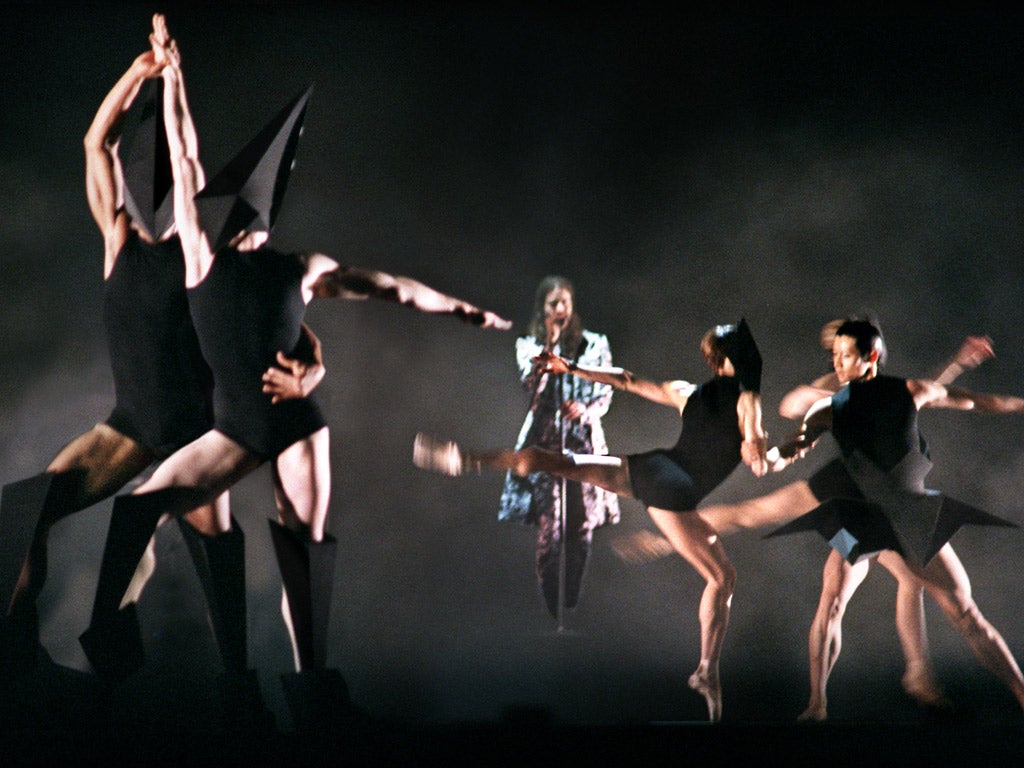Royal Ballet Triple Bill, Royal Opera House, London Anna Karenina, Coliseum, London
With rock nobility on stage and no one in the pit, a ticket for the Royal Ballet feels more like a pass to Ministry of Sound

They came in all their finery: glam-rockers in nose-rings and dog-chains, the Kensington set in full-fig Chanel. The last time the Royal Ballet attracted such a mixed crowd was in 2006, when ballet last met pop and fashion head-on. Once again the kingpin is choreographer Wayne McGregor, but now he has even more clout, summoning Gareth Pugh as designer, Mark Ronson as guitarist-composer, singer Alison Mosshart of The Kills, rappers Black Cobain and Wale, and – goodness, could that really be? – Boy George. Rufus Wainwright is credited with orchestration, though the ROH Orchestra mysteriously stayed at home. With so much else going on, no one seemed to notice.
Within this fug of creative egos, 18 dancers of preternatural elasticity muscled a way through. The title, Carbon Life, nods to personal responsibility, but McGregor treats his cast as an assemblage of jutting limbs. "Carbon Copy" might be nearer the mark, as black-knicker-clad clones march, slide, dislocate and generally spatchcock themselves in ways well rehearsed in earlier McGregor ballets. As always, certain dancers are pushed into prominence: big Ed Watson, tiny Sarah Lamb, recklessly hyperflexed Melissa Hamilton. Yet even they can't stop your gaze migrating to the musical comings and goings upstage. Potentially great moments in frozen silhouette are ruined by musicians standing in the way.
Pugh's design distracts further with a wall of vertical rods that morph into a grid that busily rises and falls. His costumes are a cabaret in themselves, from nude suits and man-tutus to Ku Klux Klan hoods, over-the-knee spats and niqab-like bodices that hide the women's chins. Viewed as a rock gig with high-end production values, Carbon Life is deservedly a hot ticket. As a chapter in the ongoing story of the Royal Ballet and its house choreographer, it's not encouraging.
Less worrying are the flaws that beset Sweet Violets, the other new work on the bill. This is young Liam Scarlett's first bite at narrative, and he's simply bitten off too much.
Braiding rumour with fact concerning Jack the Ripper and Walter Sickert, a painter with a distinctly sordid turn of mind, his plot has too many characters, too many scenes, and asks too much of an audience's comprehension. A prostitute, bundled off by heavies in an early scene, is unrecognisable half an hour later when she reappears bald and mad. Another, murdered in the first five minutes, returns as a ghost. The hollow-eyed ghoul who partners girls on the local music-hall stage turns out to be a projection of Sickert's sick imagination. Yet the old-school mimed naturalism fails to flag up these supernatural possibilities. Scarlett could have been bolder, and briefer, too. His handling of his dance ideas, on the other hand, is superbly assured, as, one must assume, is his handling of his top-rung cast who are literally prepared to scamper up the wallpaper for him (Alina Cojocaru, as Sickert's mistress) or undress (Tamara Rojo – though I really don't think ticket-holders needed the indecency warning).
John MacFarlane's dingy sets cleverly suggest the Camden Town paintings. The music, excessive and ominous by turns, is Rachmaninov's, rendered by piano trio to economical effect.
It's said that dance is an international language. Wordless it may be, but taste does not always cross national boundaries, and the narrative ballets of Boris Eifman are a case in point. A veteran of 30 years dance-making in St Petersburg, he tackles epic stories for vast stages in a style a Russian might approvingly call bolshoi – big – and we might call OTT.
Anna Karenina, opening a brief season of Eifman's work at the Coliseum, might skimp on half the plot (no Levin, no Kitty), but goes to the max on passionate angst, giving wayward Anna wings of fire in antics that would send a seasoned circus gymnast scurrying to check their personal injury cover. Maria Abashova, in the cast I saw, is a gorgeous Amazonian with a technique that should have had the house on its feet. But overstatement of the case (whether love, misery, or husband-loathing) curiously dis-empowered her. The most telling image in Eifman's ballet was the black-clad chorus embodying steam trains on a busy stretch of track.
Royal Ballet (020-7304 4000) to 23 Apr
Dance choice
In the 65th anniversary year of Tennes-see Williams's play, Scottish Ballet presents a fresh take on A Streetcar Named Desire, a collaboration between theatre and film director Nancy Meckler and choreographer Annabelle Lopez Ochoa, with a new, jazz-inflected score by Peter Salem. At Glasgow's Theatre Royal (Wed to Sat), then touring.
Join our commenting forum
Join thought-provoking conversations, follow other Independent readers and see their replies
Comments